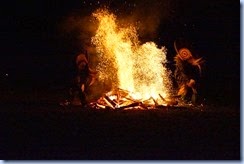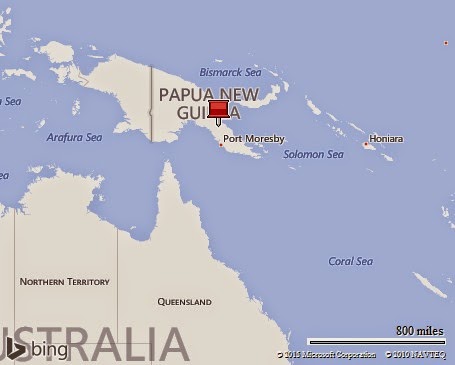Can you name the country represented by those letters? Let me give you a few clues: It occupies the eastern half of the second largest island in the world. It is part of the Oceania group of islands, and is home to over six million people. The official language is Tok Pisin, and while English is also an official language, less than 2% of the population uses it. Indeed because the country is mostly mountainous terrain, it is home to communities which have been separated for centuries, and as a result over 860 native languages have been identified. It is also home to one of the world’s largest swamps. I might also throw into the mix, the fact that the country is situated along the Pacific “Ring Of Fire” and as such, is subject to frequent and sometimes severe earthquakes, mud slides and tsunamis, and volcanic eruptions. So, what do you think?
I have been describing the country of Papua New Guinea our most recent stop on this exciting voyage. Our ship arrived into the port city of Rabaul around 5pm. During the arrival, the decks were filled with people taking photographs of the Rabaul Volcano which destroyed the city in 1937, and again in 1994. It was for this reason, that the Capital of the country was moved from Rabaul to Kokopo, after the last eruption left the city mostly in ruins. The volcano is an impressive sight which is surrounded by less active volcanos in an arc of activity.  The Rabaul volcano is still active to this day, and plumes of smoke were clearly visible spewing from its top.
The Rabaul volcano is still active to this day, and plumes of smoke were clearly visible spewing from its top.
Dinner was served very early in order that all of us could participate in an evening outing into the Baining Mountains to witness a performance of the famous Baining Fire Dance. This amazing spectacle is performed by the Baining People to commemorate important events within their community such as a birth, a good harvest, a death or the transition into manhood. In the past, this was a men’s event only, and women and children were forbidden to be present. The elaborate masks and costumes are worn for a one-time use only, and are supposed to be destroyed after each ceremony. If truth be told, the evening’s event was a performance that had been arranged on our behalf, so all around the chairs which had been setup for our use; there was a large crowd of onlookers including women and children. This is not to say that this tradition is dead. Indeed we later learned that a small child who was sick was carried by one of the dancers in the hope that the evil spirit causing his illness might be banished.
I have gotten slightly ahead of myself since first I must share our ride into the mountains. We were advised against going outside the security perimeter after dark on our own. My personal experience was that people all along the way seemed friendly all the while waving and smiling as we passed, and yet after we departed the pier, we entered a world without much if any light, and groups of young teens, who lined the dark, would find our watches or cameras irresistible in a country in which the average yearly income is only $2,800. Our drive took almost an hour along roads which at times were paved (complete with potholes here and there) or just plain dirt roads with muddy patches. There were no street lamps and the only light to pierce the darkness were small LED’s or fluorescent lamps which radiated through the thick jungle or lit the many roadside stalls around which people congregated. What truly amazed me was the sheer number of people walking along the roads in the pitch dark. The roads were narrow, and most of these people were dressed in dark clothes, not to mention that they were also dark skinned. Our caravan of vans moved along the roads at what seemed like a breakneck speed with our headlamps on low; people along the roads appeared literally out of nowhere, sometimes just a single person, sometimes entire families with children who were actually in the road itself. That alone was bad enough, but the roads were at time winding sharply and coming around a sharp curve sometimes a person would just jump with surprise. How we managed to miss hitting someone was a mystery to me.
We finally arrived all in one piece at the open area where the night’s performance was to take place. Chairs had been setup for our use, and as soon as we were seated, our vans withdrew and along with them their headlights. We were left in total darkness, and as our eyes adjusted, we realized that above us was a beautiful almost cloudless night with a half moon and canopy of brilliant stars. As is typical of “island time,” the musicians had not yet arrived, and so one of our staff scientists gave a presentation on the ancient way of the Micronesian navigators. He, himself, is a member of the Polynesian Voyaging Society whose members navigate their huge canoes around the Pacific using only these ancient techniques. His impromptu presentation about the various constellations was fascinating, and I was sorry to see him stop when the locals were ready to begin.
In front of us a fire had been glowing, but now young men started to build the fire into a roaring inferno. They kept this up for the next hour during the performance. I suddenly became aware that all around us locals had arrived and were quietly standing or sitting all around behind us. Then I became dimly aware of shadowy figures lurking just outside the light of the fire. The musicians started to play a rhythmic beat as elaborately adorned figures appeared in the light. As they danced, mostly in the shadows, one of their members from time to time would run up to and kick the roaring fire which then sent the fire even higher.  Eventually dancers appeared to run through the fire which then sent sparks heavenward in an awesome display in which the burning embers seemed to float up to the stars above.
Eventually dancers appeared to run through the fire which then sent sparks heavenward in an awesome display in which the burning embers seemed to float up to the stars above.
Now imagine how as photographers both Lisa and I were dying to capture images of what we were seeing. Think of the challenges: if we used a flash, we ruined the moment and got a photograph without real meaning. On the other hand, we were trying to take a photograph in total darkness except for the roaring fire of men who were on the move and dancing at times quite rapidly. For the entire hour both Lisa and I tried every trick we had and between us probably took over 1,000 pictures. In the end, I think I got a few that are worthy to share, but sadly no video – I just could not get it to work in the dark.
So we returned back to the ship around 10pm, hot and tired, only to be greeted on the pier by a large group of the ship’s crew holding a large sign, “WELCOME HOME.” In addition, the Hotel Department had prepared a late evening snack with live music and plenty of “refreshment.” What a wonderful and appreciated surprise.
Before our ship departed at noon the following day, we were treated to a morning tour of the Rabaul area and the nearby town of Kokopo. Truthfully, I was not overly impressed by what I saw. Papua New Guinea is still a pretty developing country. We first drove to the Volcano Observatory where there is an active monitoring of the nearby volcanos. The facility was not very modern or impressive. They had recently replaced their old thermal drum monitors with computerized displays, but funding only allows them to actually monitor 3 or 4 volcanos. I could not understand all that the resident technician said, but I did catch the question about whether or not if a volcano was about to erupt, did they have a red light or something to warn them so the locals could be warned. Sadly the technician noted, that feature broke some time back, and they do not have the funds to replace it – end of story.
Our next stop was to a WW II museum, which contained mostly old Japanese war equipment. This is logical since Japan occupied Papua New Guinea during the war and it was a major supply base. Just down the road, we stopped to view a long tunnel which had been built by the Japanese using POW’s and slave labor. Inside this tunnel were the rusting hulks of self-propelled supply barges which were used to offload supply ships and to then hide them from Allied Forces. There were one or two other stops including the local market and then it was time to say goodbye and sail on to our next stop, the small island of Tatau, Papua New Guinea.
Sadly our stop at Tatau had to be cancelled due to the rough seas. One thing the ship cannot control is the weather; so we have a day at sea as we make our way northwestward to our next scheduled stop at Kapingamarangi, Pohnpei, Federated States of Micronesia.
So go look that destination up in your “Funk and Wagnell!”
Jim




No comments:
Post a Comment